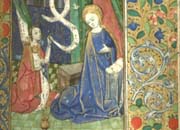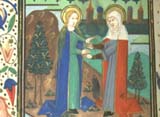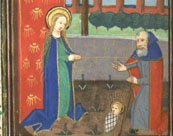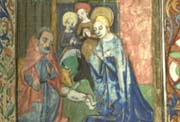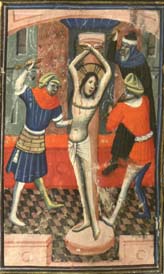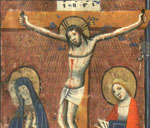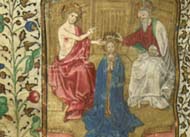Hours of the Virgin Mary
Cult of the Virgin Mary
The Virgin Mary was venerated in the early days of the Church, but the cult of the Virgin remained small until the 10th century, when it suddenly rose in popularity. By the 14th century the importance of the Virgin had grown throughout the Christian world. Books of Hours are evidence of Mary's status in the medieval Church: they provided a religious structure for a layperson's day, and the Office (or Hours) of the Virgin was at the core of the day's worship. The Hours of the Virgin contained prayers to be recited as each of the eight canonical hours: Matins, Lauds, Prime, Terce, Sext, None, Vespers, and Compline.Personal Devotion
Illustrations for the Office of the Virgin consist of either the Infancy Cycle, which depicts Mary's role in the conception, birth, and childhood of Christ, or the Passion Cycle, which depicts his death and rebirth. The images of the Infancy Cycle showcase the Virgin's purity, piety, and humility. The illustrations were not only a way in which the worshipper could venerate the Virgin; they also presented her as a model for the worshipper to contemplate and emulate.The Castle Hours 2 (above, left) and Castle Hours 3 (at right) employ the Infancy Cycle and Matins, the first hour, is illustrated in both books by the Annunciation. On the right, Mary is kneeling in prayer with a book, and on the left the Archangel Gabriel is announcing to Mary that she has been chosen to bear the son of God. This image of Mary praying with the aid of a book is particularly fitting at the beginning of the canonical hours. In addition to demonstrating how to perform one's prayers, the image also illustrates the potential for a prayer book to foster a closer relationship between the reader and God, as idealized in Mary's unique relationship with the divine.
The Visitation
Lauds is usually illustrated by the Visitation, where the Virgin Mary and her cousin St. Elizabeth, the mother of St. John the Baptist, meet and find that they are both miraculously with child. Some worshippers, having arisen for Matins, prayed straight through Lauds as well. For this reason, the Hour of Lauds is sometimes marked in a Book of Hours only by a large and decorative initial in the text, rather than by a full page illustration.
The Pious Mother
In images of the Nativity that accompany Prime, one would assume the central figure in the Nativity would be the Christ Child. Both Mary and Joseph seem to be looking at the tiny figure.As one's eyes move across the illustrations, however, it becomes clear that it is Mary, framed against the red and gold cloth, who is the central character. The focus of this illustration is the Virgin's piety, shown here through her worship of the Christ Child.
The Little Hours
Terce, Sext, and None are known as the "little hours" and are composed primarily of psalms. The Streeter-Piccard Hours and the Mongan Hours, illustrated below, employ the Passion Cycle images throughout the Hours of the Virgin, allowing users to meditate on the Biblical events that culminate in the Crucifixion and Resurrection – and the forgiveness of human sins.
Terce
An image of the Flagellation of Christ is used at Terce. This hour, according to the Fathers of the Church, corresponded to the hour of Christ's condemnation to death. The illumination shows Christ tied to a column, often described as a support of the Temple, while two men whip or beat him. Gazing upon this image, or imitating it through self-flagellation, was a way for medieval users to enter into Christ’s suffering.
Sext
An image of Christ Carrying the Cross is used at Sext. The Church regarded this hour as one of the holiest because it was the hour at which Adam and Eve ate the fatal apple, at which three angels met Abraham, and at which Christ was nailed to the cross. In this illustration Christ, with the rather unconventional help of the Virgin Mary as well as a bearded man, carries his cross before a crowd.
None
The Crucifixion was used to illustrate None, the hour corresponding to Christ's death. This illumination shows Christ crucified, with Mary at his side. Another female saint, perhaps Mary Magdalene, stands to the right of Christ holding a book. Inserted within the image, the book serves as a reminder of the purpose of prayer with one's Book of Hours.
Vespers and Compline
Vespers and Compline are the final two sections of the Hours of the Virgin, with Vespers recited in the early evening and Compline before bedtime. Like the other Hours of the Virgin, Vespers and Compline invoke aid and comfort from the Virgin Mary. This would have created an enormous personal bond between each reader, his or her prayers, and the book itself, as well as a constant reinforcement of the importance of the Virgin.In Books of Hours that use the Passion Cycle images for the Hours of the Virgin, Vespers is usually illustrated by the Deposition. In this image, Mary can be seen praying with John the Evangelist and others, as Christ's bleeding body is carried down from the cross.

